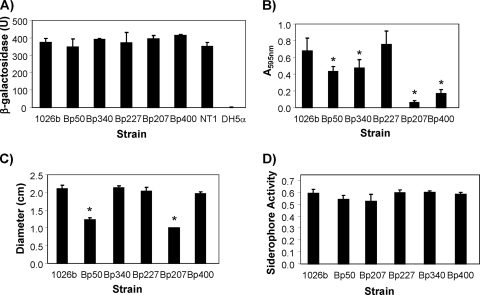FIG. 2.
Production of acylated homoserine lactones and selected virulence factors in B. pseudomallei efflux mutants. The following strains were analyzed: 1026b, wild type; Bp50 and Bp340, Δ(amrRAB-oprA) derivatives of 1026b; Bp207 and Bp400, Δ(amrRAB-oprA) Δ(bpeAB-oprB) derivatives of 1026b; and Bp227, a Δ(bpeAB-oprB) derivative of 1026b. For AHL production assays, the positive control was A. tumefaciens strain NT1/pTiC58 ΔaccR and the negative control was E. coli DH5α. (A) AHL production was measured as AHL-stimulated β-galactosidase activity, using the A. tumefaciens indicator strain NT4/pZLR4, as described in Materials and Methods. (B) Biofilm formation was assayed using adhesion to polystyrene, followed by crystal violet staining and measuring the amount of solubilized dye at 595 nm. (C) Swimming motility was assessed by inoculation of LB-0.3% agar plates, followed by measurement of diameters of the resulting migration zones. (D) Total siderophore activity was measured using a universal chrome azurol S siderophore assay. Data shown are from experiments performed in triplicate and on three separate occasions. Errors bars represent standard deviations. Asterisks indicate levels of biofilm formation and swimming motility that are statistically significantly different (according to t test) from those detected in 1026b.

